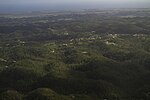Mogote

A mogote (/məˈɡoʊti/)[1] is a generally-isolated steep-sided residual hill in the tropics composed of either limestone, marble, or dolomite. Mogotes are surrounded by nearly flat alluvial plains. The hills typically have a rounded, tower-like form.
Overview[]
This term is used for hills, isolated or linked, with very steep, almost vertical, walls, surrounded by alluvial plains in the tropics, regardless of whether the carbonate strata in which they have formed are folded or not.[2][3]
Mogotes are common in the karst areas of the Caribbean, specially in Cuba and Puerto Rico. The word mogote comes from the Basque word 'mokoti' meaning "sharp-pointed" ('moko' meaning "mountain peak").[4] In Puerto Rico, several mogotes along a ridge are called pepinos.[5]
Gallery[]

Mogotes in Puerto Rico rising out of pineapple fields in a plain of blanket sand near Coto Sur. The quarry in the left background is 1 kilometer east of Manati.

Two mogotes showing their typical rounded shape in Viñales Valley in Pinar del Río Province, western Cuba

Mogotes, Northern Matanzas Province, near the city of Cárdenas, Cuba
Mogotes in Northern Cuba, between Matanzas and Havana Provinces

View of mogotes along the Northern karst zone of Puerto Rico.

Mogotes in Sector Hess in Esperanza, Arecibo, Puerto Rico.
See also[]
References[]
- ^ "mogote - Definition of mogote in English by Oxford Dictionaries". Oxford Dictionaries - English.
- ^ Neuendorf, K. K. E., J. P. Mehl, Jr., and J. A. Jackson, 2005, Glossary of Geology, 5th ed. American Geological Institute, Alexandria, Virginia. 779 p. ISBN 0-922152-76-4
- ^ U.S. Environmental Protection Agency, 2002, A Lexicon of Cave and Karst Terminology with Special Reference to Environmental Karst Hydrology (2002 Edition). U.S. Environmental Protection Agency, Office of Research and Development, National Center for Environmental Assessment, Washington Office, Washington, D.C., EPA/600/R-02/003. 221 p.
- ^ ASALE, RAE-; RAE. "mogote | Diccionario de la lengua española". «Diccionario de la lengua española» - Edición del Tricentenario (in Spanish). Retrieved 2021-09-19.
- ^ BALGHIN, W. G. V.; COLEMAN, A. (5 March 1965). "Puerto Rico". Geography. 50 (3): 274–286. JSTOR 40567047.
Further reading[]
- Day, M.J. (March 1978). "Morphology and distribution of residual limestone hills (mogotes) in the karst of northern Puerto Rico". Geological Society of America Bulletin. 89 (3): 426–32. doi:10.1130/0016-7606(1978)89<426:madorl>2.0.co;2.
- Inselbergs
- Landforms of Cuba
- Erosion landforms
- Karst
- Topography stubs




